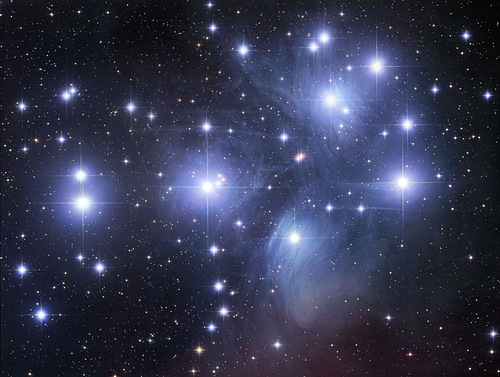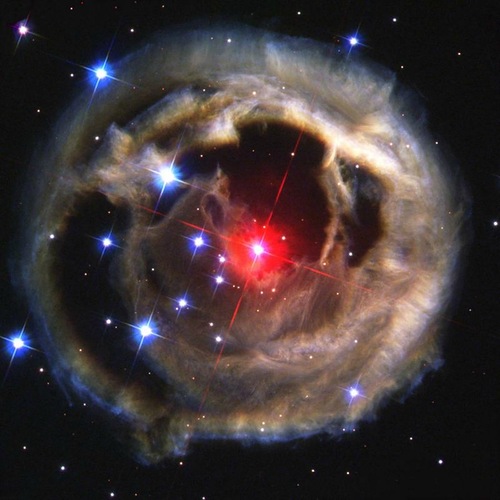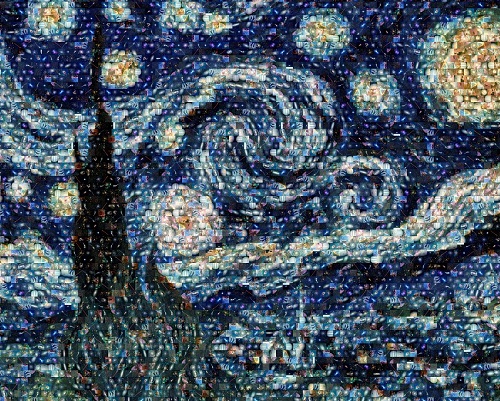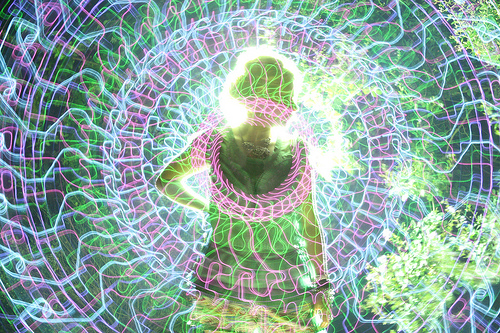Astronomy Picture of the Day
Astronomy Picture of the Day – website, where each day they show a different image or photograph of our fascinating universe. In addition, they provide a brief explanation written by a professional astronomer. The Pleiades Star Cluster is the most famous star cluster on the sky, the Pleiades seen without binoculars from even the depths of a light-polluted city. Also known as the Seven Sisters and M45, the Pleiades is one of the brightest and closest open clusters. The Pleiades contains over 3000 stars, is about 400 light years away, and only 13 light years across. Quite evident in the above photograph are the blue reflection nebulae that surround the brighter cluster stars.
One can see the cluster, dominated by bright blue stars, with the naked eye in a dark sky in the tail of the constellation of the Scorpion. M7 contains about 100 stars in total, is about 200 million years old, spans 25 light-years across, and lies about 1000 light-years away. The above deep exposure taken from Hakos Farm in Namibia. Known since ancient times, Ptolemy noted The M7 star cluster in 130 AD. Also visible are a dark dust cloud and literally millions of unrelated stars towards the Galactic center.
The beauty of the ancient domes of the Bungle Bungle Range in Western Australia. These picturesque domes appear as huge layered beehives and are made of sandstones and conglomerates deposited over 350 million years ago. Advocates for the sky might laud the beauty of the Milky Way’s central band shown arching from horizon to horizon. The photogenic Milky Way band formed over 10 billion years ago and now includes many well-known nebulae and bright stars. Fortunately, you don’t have to decide and can enjoy both together in this beautiful 8-frame panorama taken from the dark skies of Purnululu National Park about two months ago.
A 180 degree wide-angle panorama made in four exposures on August 24, the scene does look to the north and the sky is suffused with an eerie greenish light. Still, the subtle glowing bands are not aurora, but air glow. Unlike aurora powered by collisions with energetic charged particles and seen at high latitudes, air glow is due to chemiluminescence, the production of light in a chemical reaction, and found around the globe. The chemical energy is provided by the Sun’s extreme ultraviolet radiation. Like aurora, the greenish hue of this air glow does originate at altitudes of 100 kilometers or so dominated by emission from excited oxygen atoms. More easily seen near the horizon, air glow keeps the night sky from ever being completely dark.

In this serene night skyscape, the Milky Way’s graceful arc stretches over prominent peaks in the Italian Alps known as Tre Cime di Lavaredo
In this serene night sky scape, the Milky Way’s graceful arc stretches over prominent peaks in the Italian Alps known as Tre Cime di Lavaredo. A 180 degree wide-angle panorama made in four exposures on August 24, the scene does look to the north and the sky is suffused with an eerie greenish light. Still, the subtle glowing bands are not aurora, but airglow. Unlike aurora powered by collisions with energetic charged particles and seen at high latitudes, airglow is due to chemiluminescence, the production of light in a chemical reaction, and found around the globe. The chemical energy is provided by the Sun’s extreme ultraviolet radiation. Like aurora, the greenish hue of this air glow does originate at altitudes of 100 kilometers or so dominated by emission from excited oxygen atoms. More easily seen near the horizon, air glow keeps the night sky from ever being completely dark.

The Prawn Nebula South of Antares, in the tail of the nebula-rich constellation Scorpius, lies emission nebula IC 4628
The Prawn Nebula South of Antares, in the tail of the nebula-rich constellation Scorpius, lies emission nebula IC 4628. Nearby hot, massive stars, millions of years young, radiate the nebula with invisible ultraviolet light, stripping electrons from atoms. The electrons eventually recombine with the atoms to produce the visible nebular glow, dominated by the red emission of hydrogen. At an estimated distance of 6,000 light-years, the region shown is about 250 light-years across, spanning an area equivalent to four full moons on the sky. The nebula is also cataloged as Gum 56 for Australian astronomer Colin Stanley Gum, but seafood-loving astronomers might know this cosmic cloud as The Prawn Nebula.
The famous Horse-head Nebula in Orion is not alone. A deep exposure shows that the dark familiar shaped indentation, visible just below center, is part of a vast complex of absorbing dust and glowing gas. To bring out details of the Horsehead’s pasture, amateur astronomers at the Star Shadow Remote Observatory in New Mexico, USA fixed a small telescope on the region for over seven hours filtering out all but a very specific color of red light emitted by hydrogen. They then added the image to a full color frame taken over three hours. The resulting spectacular picture details an intricate tapestry of gaseous wisps and dust-laden filaments that were created and sculpted over eons by stellar winds and ancient supernovas. The Horse head Nebula lies 1,500 light years distant towards the constellation of Orion. Two stars from the Orion’s Belt can be found in the above image.
Rising at sunset, the gorgeous Full Moon of August 31 became the second Full Moon in a month. According to modern reckoning, that makes it a Blue Moon. In fact, parts of the Full Moon do look a little blue in this sharp lunar portrait. Taken just hours before the exact full phase in delightfully clear skies over Nottingham, UK, it features eye-catching bright rays extending from the prominent young crater Tycho in the Moon’s southern hemisphere. The slightly color enhanced image also brings out subtle shades of blue, a real characteristic of terrain with a high content of titanium oxide and iron. The blue lunar terrain on the right includes the dark flat expanse of the Sea of Tranquility and the Apollo 11 landing site.
Astronomy Picture of the Day
This graceful arc traces an Atlas V rocket climbing through Thursday’s early morning skies over Cape Canaveral Air Force Station in Florida, USA. Snug inside the rocket’s Centaur upper stage were NASA’s twin Radiation Belt Storm Probes (RBSP), now in separate orbits within planet Earth’s Van Allen radiation belts. Reflected in the Turn Basin from a vantage point about 3 miles from Space Launch Complex 41, the scene was captured in a composite of two exposures. One highlights the dramatic play of launch pad lighting, clouds, and sky. A subsequent 3 minute long exposure records the rocket’s fiery trail. While most spacecraft try to avoid the radiation belts, named for their discoverer James Van Allen, RBSP’s mission will be to explore their dynamic and harsh conditions.
apod.nasa.gov












